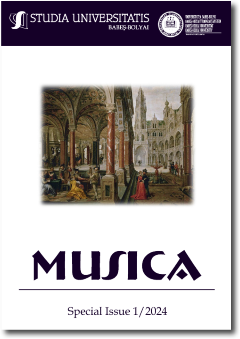The Evolution of the French Chanson During the Renaissance: From the Parisian Chanson to the Pléiade Chansons, and the Air du Cour
DOI:
https://doi.org/10.24193/subbmusica.2024.spiss1.05Keywords:
chanson, French, Renaissance, La Pléiade, musique mesuréeAbstract
The present article traces the evolution and development of the French chanson, focusing on the Parisian chanson and the changes underwent by the genre under the influence of the group La Pléiade. One of the most important contributions France has made to the music of the Renaissance, the chanson embodies the endeavors that guided French artists of the Renaissance to prove that the French language possessed all the necessary qualities for becoming a poetic language. Relinquishing the sobriety of the Franco-Flemish school, Renaissance composers turned to a simpler, more melodious expression in their works, striving to place the text at the forefront. The 1520’s witnessed the emergence of a new type of chanson, generally known as the Parisian chanson, with its lyrical and narrative versions, exemplified by the works of such composers as Claudin de Sermisy or Clément Janequin. From the complex polyphonic works, composers turned to more transparent textures, characterized by homorhythm and homophony. The chanson was also influenced by the ideals proposed by the Pléiade group, which placed poetry at the forefront, the music following the metric and rhythmic patterns of the declamation – a practice that became known as musique mesurée and was represented by the works of Claude Le Jeune. Finally, the end of the 16th century brought about the gradual replacement of the genre with the air du cour, which would gain popularity in the 17th century. Nonetheless, the particularities of the musique mesurée would have a great influence on declamation and the importance of the accents in song – concepts that lies at the core of French vocal music of the following centuries. The analysis proposed by the authors presents pieces that are representative for the evolution of the genre, striving to reveal the particularities of each period in the development of the chanson.
References
Brooks, Jeanice. Courtly Song in Late Sixteenth-Century France. Chicago, 2000.
Brooks, Jeanice. France, ii: 1560–1600 in Studies in Medieval and Renaissance Music 5 – European Music 1520–1640, edited by James Haar. The Boydell Press, Woodbridge, 2006.
Brown, Howard M. The Chanson Rustique: Popular Elements in the 15th- 16th Century Chanson in Journal of the American Musicological Society 12 (1959), pp. 6-26.
Bernstein, Lawrence F. Notes on the Origin of the Parisian Chanson in The Journal of Musicology, Vol. 1, No. 3 (Jul. 1982, pp. 275-326).
Elders, Willem. Josquin des Prez and His Musical Legacy. An Introductory Guide. Leuven University Press, Belgium, 2013.
Haar, James. The Concept of the Renaissance in Medieval and Renaissance Music 5 – European Music 1520–1640, edited by James Haar. The Boydell Press, Woodbridge, 2006.
Knecht, R.J. Francis I. Cambridge University Press, 1984.
Lütteken, Laurenz. Music of the Renaissance - Imagination and Reality of a Cultural Practice. California: University of California Press, 2019.
Morley, Thomas. Plaine and Easy Introduction (1597), edited by Alec Harman, London 1952.
Ouvrard, Jean-Pierre. Modality and text expression in 16th-century French chansons: remarks concerning the e mode in Basler Jahrbuch für historische Musikpraxis: eine Veröffentlichung der Schola Cantorum Basiliensis, Lehr- und Forschungsinstitut für Alte Musik an der Musik – Akademie der Stadt Basel, Amadeus Verlag, 16 (1992), (pp.89-116).
Van Orden, Kate. Chanson and Air in Studies in Medieval and Renaissance Music 5 – European Music 1520–1640, edited by James Haar. The Boydell Press, Woodbridge, 2006.
Downloads
Published
How to Cite
Issue
Section
License
Copyright (c) 2024 Studia Universitatis Babeș-Bolyai Musica

This work is licensed under a Creative Commons Attribution-NonCommercial-NoDerivatives 4.0 International License.






